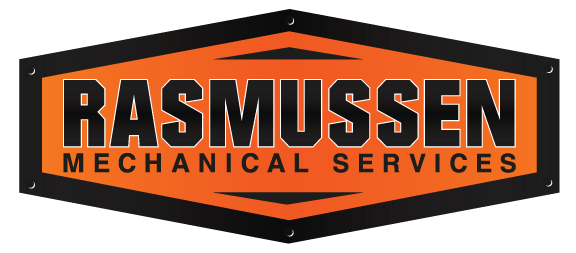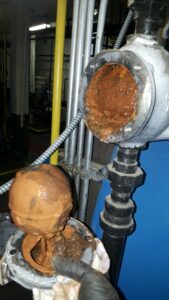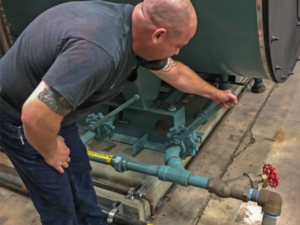Boiler water treatment is essential for the safe, efficient, and long-lasting operation of industrial and commercial boiler systems. Without proper treatment, water impurities can lead to scale, corrosion, sludge buildup, and carryover. All of these issues degrade efficiency, cause costly downtime, and shorten equipment life. This article explores the fundamentals of water treatment, common problems it prevents, the core treatment methods, and how different boiler system are affected. Understanding these principles is critical for any technical professional responsible for operating or maintaining boiler systems.
Introduction: Why Water Treatment Matters
Water is the lifeblood of a boiler system — but it also represents one of the greatest threats to its performance and longevity. Untreated or poorly treated water can deposit minerals, corrode internal surfaces, foul piping, and carry contaminants into the steam system.
Boiler water treatment programs are designed to manage these risks by controlling water chemistry before, during, and after it enters the boiler. A well-executed program maximizes energy efficiency, minimizes unscheduled maintenance, protects system components, and extends boiler life.
Across all boiler types, certain treatment goals are universal:
- Prevent scale formation on heat exchange surfaces
- Inhibit corrosion of metal components
- Control the buildup of sludge and sediment
- Prevent boiler water carryover into steam systems
- Maintain chemical balance to support efficient operation
While these fundamentals apply broadly, treatment programs must be adjusted based on the boiler system type and how water flows through the process.
Common Problems Caused by Poor Water Treatment
Formation Of Scale
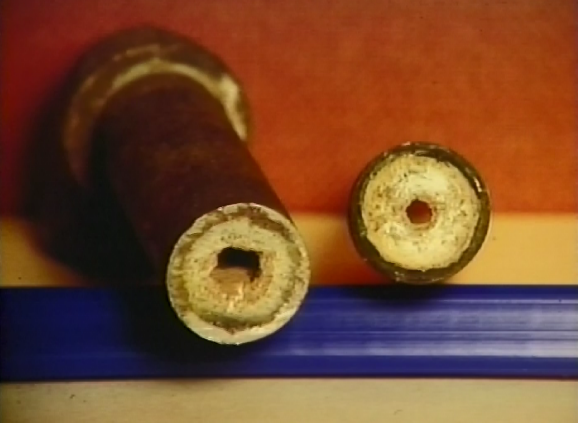
Scale caused by calcium and magnesium in the water.
Scale is a hardened layer of mineral deposits — primarily calcium, magnesium, silica, and iron compounds — that adheres to boiler surfaces. Even a thin layer of scale can significantly reduce heat transfer efficiency. This forces the boiler to burn more fuel and increases the risk of overheating and tube failure.
Steam boilers are particularly vulnerable to scale due to increased use of make-up water and concentration of minerals that build up in the boiler water. Hydronic systems (hot water boilers) may experience slower scaling rates but still require vigilance.
According to the U.S. Department of Energy, just 1/32 inch of scale can increase boiler energy use by 2–5%.
Corrosion
Corrosion is the gradual degradation of metal components due to chemical reactions with water and dissolved gases, especially oxygen and carbon dioxide. Left unchecked, corrosion can cause pitting, tube failures, leaks, and structural failures.
Steam-generating boilers face corrosion challenges inside the boiler and in the condensate return lines due to carbonic acid formation.Closed hydronic systems mainly battle internal corrosion caused by oxygen ingress from poor sealing or inadequate initial water deaeration.
Controlling pH, removing dissolved oxygen, and applying corrosion inhibitors are vital to protect system integrity.
Sludge and Sediment Buildup
Sludge forms when suspended solids and precipitated minerals settle at the bottom of the boiler. This build up reduces heat transfer, creates hot spots, and can shelter corrosive agents against metal surfaces.
Hydronic heating systems with minimal water loss still accumulate sludge over time due to corrosion byproducts but at a much slower rate. Steam systems, receiving continuous makeup water, must actively manage sludge through effective blowdown practices.
Carryover
Carryover occurs when boiler water, containing dissolved solids and impurities, is entrained into the steam. This wet, contaminated steam can foul steam turbines, heat exchangers, and process equipment. It also can cause waterhammer which can be extremely dangerous.
Steam boilers operating at higher pressures or with poorly controlled water chemistry are especially at risk for carryover.
Core Components of a Successful Boiler Water Treatment Program
1. Feedwater Pretreatment
Proper water treatment starts before water ever enters the boiler. Feedwater must be conditioned to remove contaminants that would otherwise cause scale or corrosion.
Common pretreatment methods include:
- Softening: Removes calcium and magnesium ions that cause hardness.
- Dealkalization: Reduces alkalinity to limit scaling and corrosion.
- Reverse Osmosis (RO): Removes a wide range of dissolved solids, silica, and organics.
- Deaeration: Physically removes dissolved oxygen and carbon dioxide before water enters the boiler.
Steam boilers require continuous feedwater pretreatment to manage incoming impurities. Hydronic hot water systems typically only need high-quality water for initial fill and occasional makeup. That intial fill water must be carefully controlled to minimize corrosion risks over time.
2. Internal Chemical Treatment
Once water is in the boiler, internal chemical treatment programs keep impurities under control and protect boiler materials.
Core chemical treatments include:
- Oxygen Scavengers: Chemicals like sodium sulfite or DEHA remove residual oxygen to prevent pitting corrosion.
- Scale Inhibitors: Phosphates, polymers, or chelants prevent mineral precipitation on boiler surfaces.
- Corrosion Inhibitors: Chemicals such as nitrites, molybdates, and filming amines protect metal surfaces.
- pH Adjusters: Alkalinity boosters maintain a stable pH, critical for preventing both acidic and caustic corrosion.
In steam systems, additional chemicals like neutralizing and filming amines are often used to protect condensate return piping from carbonic acid corrosion. In hydronic systems, internal treatment focuses heavily on corrosion inhibition and pH buffering, with less emphasis on scale control if makeup water is minimal.
3. Blowdown Management
The intentional removal of boiler water to control concentrations of dissolved solids and sludge is called blowdown.
- Bottom Blowdown: Removes sludge and sediment accumulating at the bottom of the boiler.
- Surface Blowdown: Controls the concentration of dissolved solids (TDS) at the water surface.
Blowdown is critical in steam boilers because the act of creating steam concentrates minerals in the boiler. As steam leaves, any elements that were in the water are left behind. Without regular blowdown, TDS levels rise, leading to foaming, priming, carryover, and scaling.
Hot water (hydronic) boilers require far less frequent blowdown, often only for periodic maintenance or when water quality testing indicates a need.
Best practices, according to the American Boiler Manufacturers Association (ABMA), include automating blowdown based on continuous conductivity measurements.
4. Water Quality Monitoring
Continuous monitoring is the foundation of any successful treatment program.
Key parameters to monitor:
- Conductivity: Indicates the total dissolved solids (TDS) concentration.
- pH: Should remain within recommended ranges to minimize corrosion.
- Hardness: Indicates risk for scale formation.
- Alkalinity: Balances pH and buffer capacity.
- Dissolved Oxygen: Should be minimized to prevent corrosion.
Regular sampling and trending of these parameters help operators spot issues early and adjust chemical dosing or operational practices accordingly.
Industry Best Practices and Guidelines
Organizations like the American Society of Mechanical Engineers (ASME) and the ABMA provide widely accepted guidelines for boiler water quality.
Key recommendations include:
- Maintain pH between 10.5–11.0 for steam boilers and 8.5–10.0 for hydronic systems.
- Keep dissolved oxygen levels below 7 ppb (parts per billion) in feedwater.
- Control TDS and blowdown rates based on system pressure and operational demands.
- Use appropriate chemical treatments to prevent scale and corrosion.
- Perform regular water testing and trending to inform treatment adjustments.
Following these standards ensures safe operation, maximized efficiency, and extended boiler life.
Conclusion: The Value of Consistent Water Management

Corrosion caused by poor feed water.
Water treatment is not a one-time task — it’s a continuous process critical to protecting your boiler investment. Proper water treatment improves energy efficiency, minimizes repair costs, enhances reliability, and extends the useful life of both boilers and connected equipment.
Whether managing a steam-generating boiler or a hydronic heating system, success depends on:
- Starting with properly conditioned water
- Applying the right internal chemical treatments
- Implementing effective blowdown practices
- Monitoring water quality trends over time
Understanding the differences between system types ensures that treatment strategies are tailored to actual operating conditions. However, the commitment to disciplined water management remains the same across all boiler systems.
A consistent, well-designed boiler water treatment program isn’t just good practice — it’s an essential investment in your operation’s safety, efficiency, and profitability.
If your having boiler issues, contact the boiler experts at Rasmussen Mechancial Services today!
FAQ
Can you run a boiler with untreated water? Running a boiler with untreated water is extremely risky. It leads to rapid scaling, corrosion, efficiency losses, and potential catastrophic failure. Even short-term operation without treatment can cause long-term damage.
Is feedwater treatment always necessary? Yes. Even high-quality municipal water contains minerals and dissolved gases that can damage boilers. Pretreatment—like softening, deaeration, or reverse osmosis—removes harmful impurities before water enters the system.
What is the difference between internal and external boiler water treatment? External treatment prepares feedwater before it enters the boiler (e.g., softening, deaeration, filtration). Internal treatment uses chemicals inside the boiler to manage remaining impurities, prevent scale, inhibit corrosion, and control pH.
How do you choose the right boiler water treatment program? Choosing the right program depends on boiler type, operating pressure, water source quality, and system design. A water analysis is essential to tailor pretreatment equipment, chemical selection, and monitoring practices.
Does feedwater temperature matter in boiler water treatment?
Yes. Feedwater should be heated (usually 180°F–220°F) before entering the boiler to reduce dissolved oxygen and improve system efficiency. Colder feedwater increases thermal shock risk and oxygen corrosion.
